We recently had the chance to spend a full day immersed in Freiburg im Breisgau. I absolutely recommend making a stop there too if you have the opportunity.
This beautiful town of 230,000 inhabitants in Germany’s Black Forest region provided a good reminder of the country’s rich lifestyle and gastronomic culture – something often underappreciated by us French neighbors!
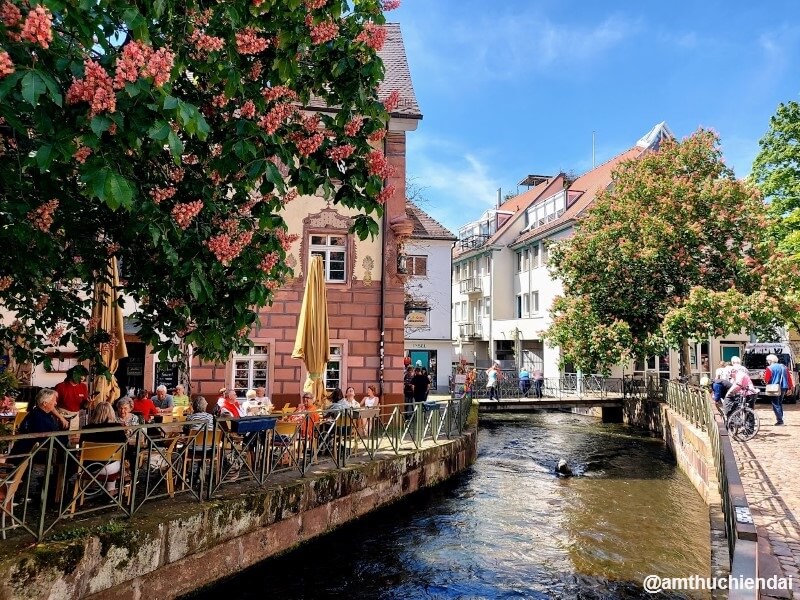
In this article, we aim to not only share recommendations specific to Freiburg itself. We will also try to highlight some of the broader German cultural traits that shape much of southwest Germany and that we had the time to fully appreciate during our visit.
Where is Freiburg im Breisgau?
To get started, we know that we do not expect you to fly across the world only to visit Freiburg im Breisgau.
That being said, the city enjoys an ideal location at the crossroads of some of Europe’s most interesting regions:
- The city sits in the heart of the major Baden wine-growing region (more on that in a dedicated section).
- It lies on the western edge of the scenic Black Forest, known for dense evergreen forests and picturesque villages.
- The city is situated in the lower Rhine Valley, one of the backbone of Europe with plenty of worthwhile spots to visit.
- Freiburg borders both France and Germany, even sharing its airport with Mulhouse, France, and Basel, Switzerland – two cities absolutely worth visiting.
In short, visiting Freiburg can be perfectly included as a stop on a trip exploring this part of Europe.
Historic Old Town
Freiburg perfectly encapsulates the experience of the old Medieval Northern Europe town not only because of a few iconic buildings but also because of the general structure of its city center built around narrow streets.
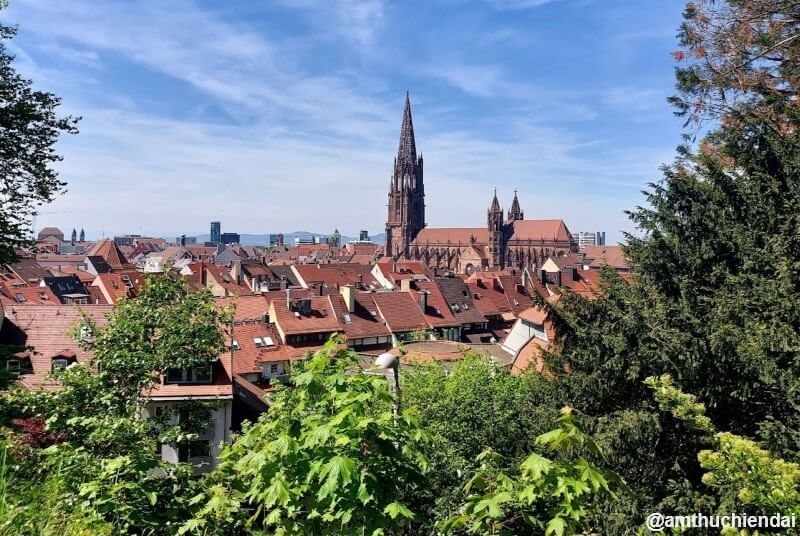
Interestingly, the historical city center was almost completely destroyed during the 2nd World War bombing but was rebuilt to preserve its identity.
Among the must-see:
Freiburg’s Münster (cathedral) and Minster Square
Both of them are located in the heart of the historical center – you won’t miss them.
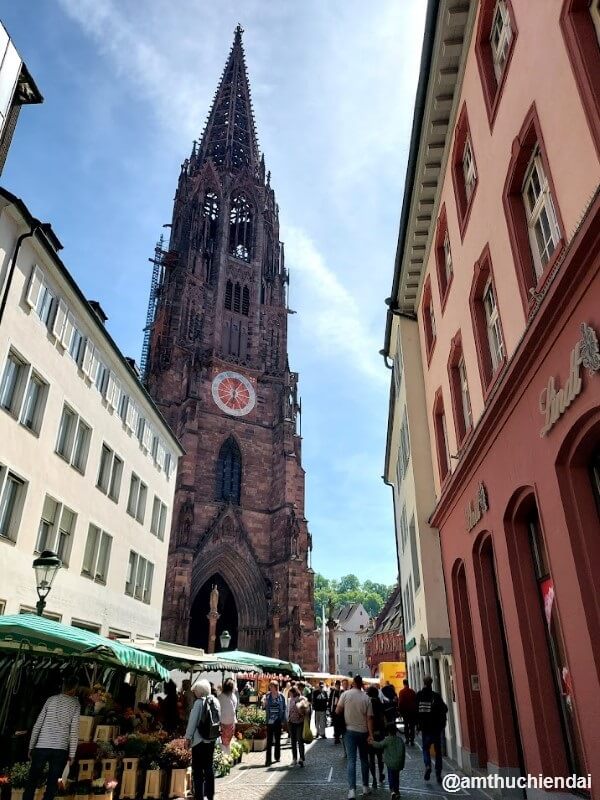
The Münster is a Gothic Cathedral particularly renowned especially for its 116-meter-high spire which, according to the Swiss historian Jacob Burckhardt, is the most beautiful spire on earth. Fortunately, the edifice miraculously survived the Second World War bombing while most of the surrounding buildings were completely flattened.
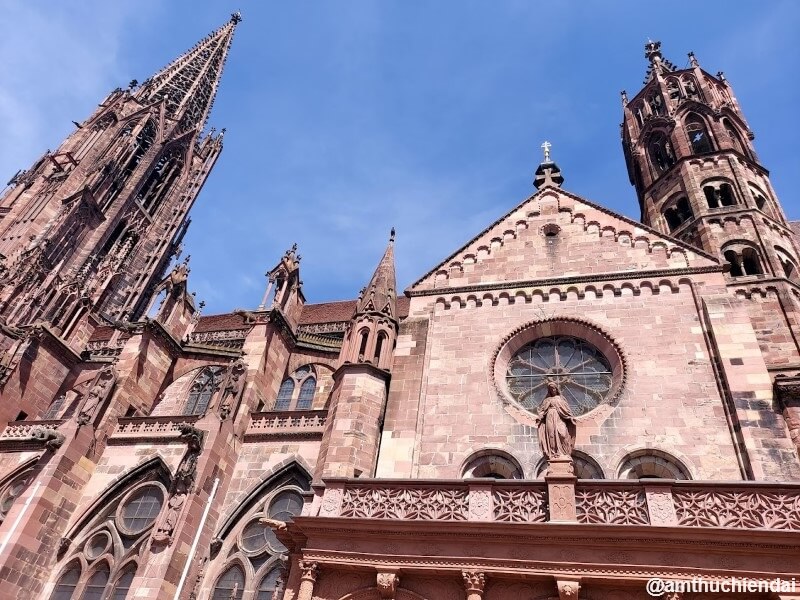
This cathedral is located at the center of Minster Square. It’s the biggest Square in the historical center of Freiburg. The square hosts a lively market where you’ll find plenty of regional products and is surrounded by several notable buildings such as the Merchant’s Hall.
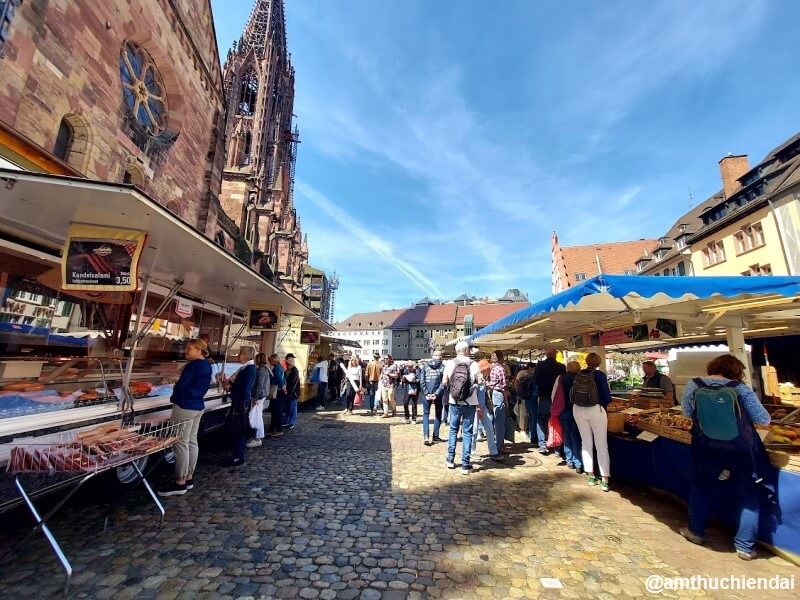
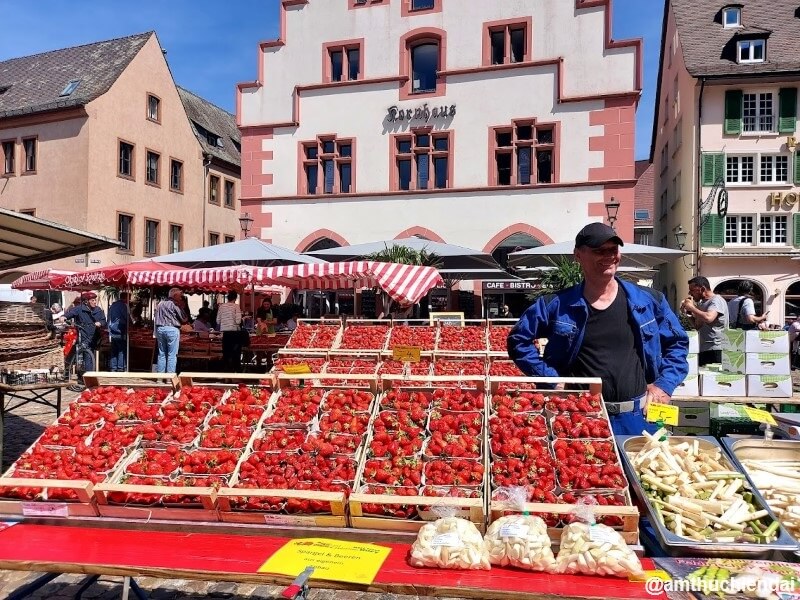
Water streams (Freiburg Bächle)
The city has an unusual system of gutters (called Freiburg Bächle) that run throughout its center. These Bächle, once used to provide water to fight fires and feed livestock, are constantly flowing with water diverted from the Dreisam.
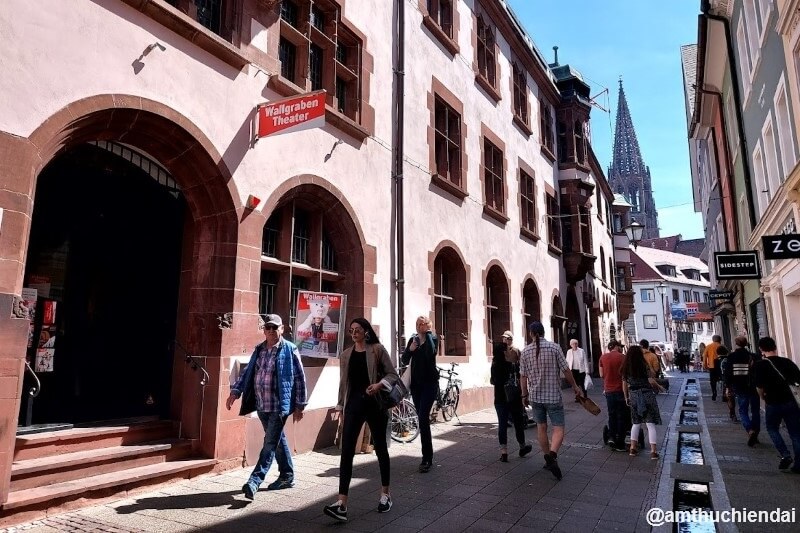
It’s clean water (we saw young children playing in it) running across several parts of the city’s streets, giving this historical center another original touch.
Colombischlössle
The Colombischlössle is a manor house in the city center of Freiburg im Breisgau where the eponymous archaeological museum is situated. We did not visit the museum, but you will likely pass in front of it if you arrive by train as it’s located in the immediate proximity of the train station.
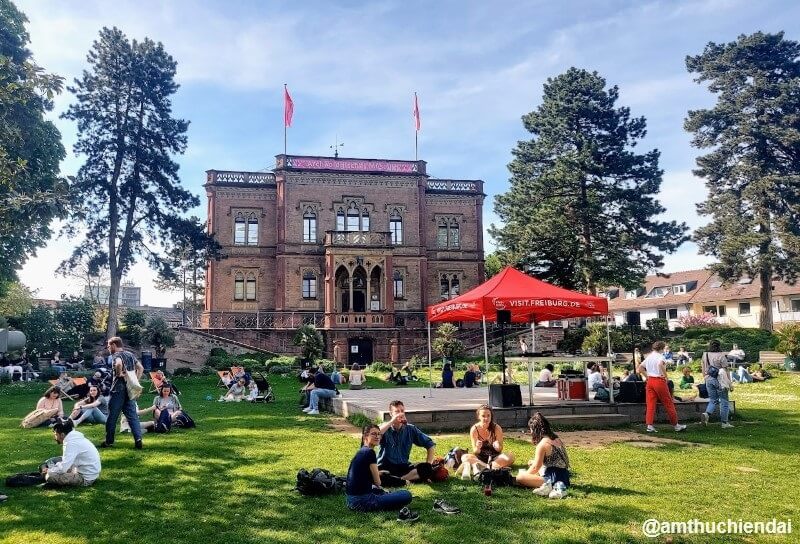
Surrounding the museum is a park. The park apparently used to have a bad reputation (drug use and muggings), but during our visit, it was very lively with people relaxing under the sun and even a small market selling drinks and food.
City gates
Freiburg used to have up to five city gates. It now has two remaining: the Schwabentor and the Martinstor, whose origin can be traced up to the 13th century.
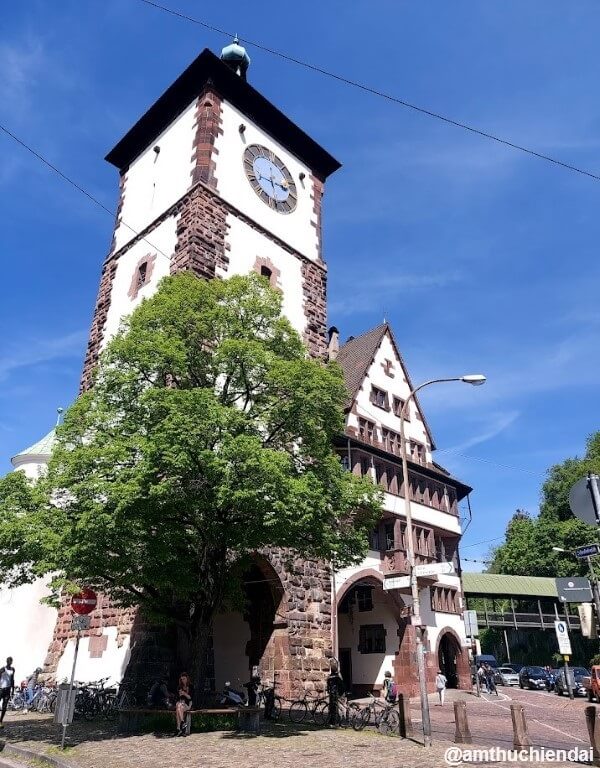
Interestingly, in light of plans for the construction of an electric trolley car line at the end of the 19th century, some citizens and businessmen were demanding their demolitions as critics viewed them as obstacles to the development of a modern transportation system. But the mayor did not cave in, saying that “a village has roofs and a city has towers.”
The current tram network passes under both gates, still demonstrating today that it’s possible to combine modernity and history.
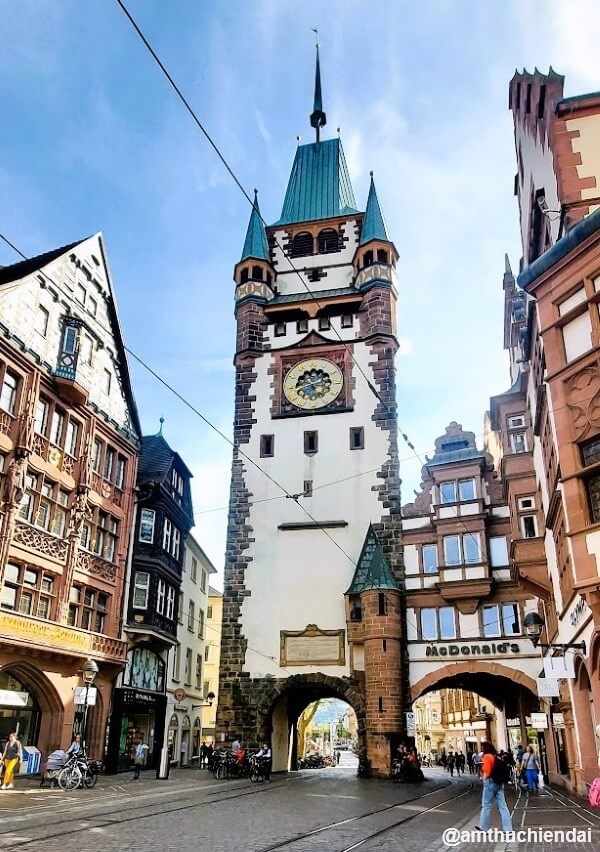
Markthalle
If after visiting and walking across the historical city you start to feel a bit hungry, make a stop at the Markthalle. That’s what we did.
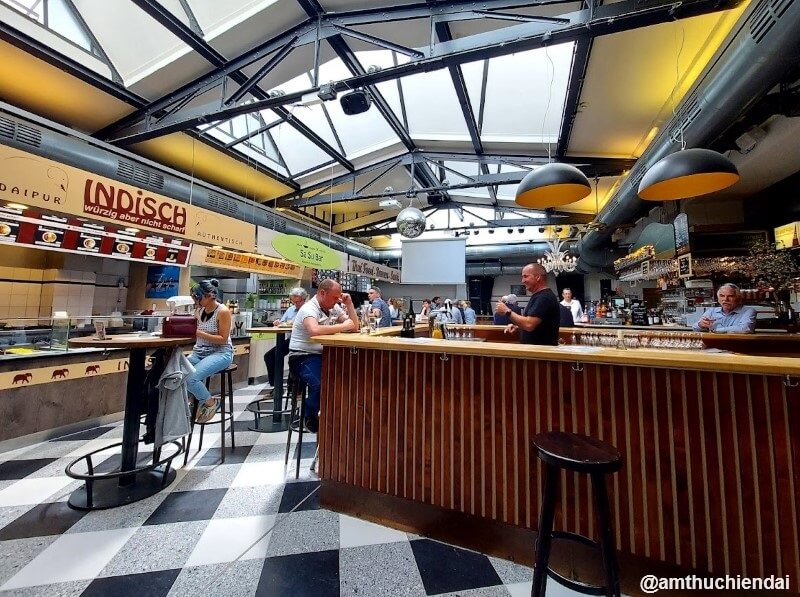
This very centrally located food court offers 20 different kinds of cuisine, going from traditional German (of course) to Afghan and Italian.
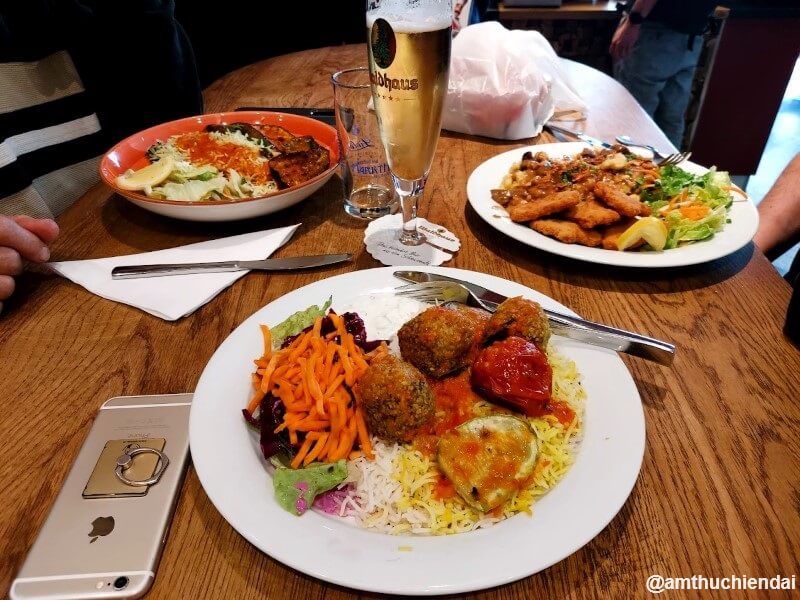
Value for price is pretty good, which explains why the place is very popular both among locals and tourists.
Schlossberg
Immediately overlooking the historical city center is another unmissable landmark – The Schlossberg (Castlehill).
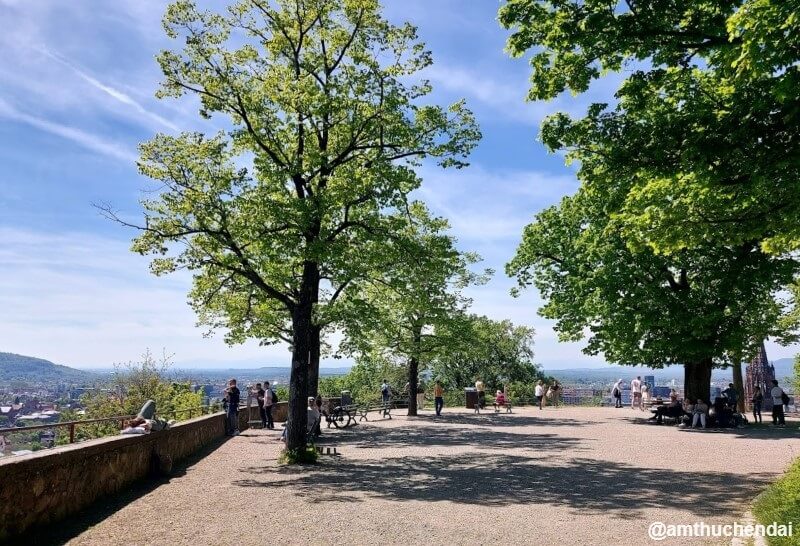
It’s a tree-covered hill of 456 meters high that has seen multiple fortified structures built since the 11th century.
We recommend you make the climb (or take the cable car) not only for the very scenic viewpoints on the city but also for the various historical landmarks spread in this area. The most famous and easily accessible one is likely the Kanonenplatz.
Wine – A city at the heart of Baden wine Region
Freiburg is located in the heart of one of Germany’s largest wine regions (The Baden wine region). If you have any interest in wine it’s something you absolutely cannot miss.
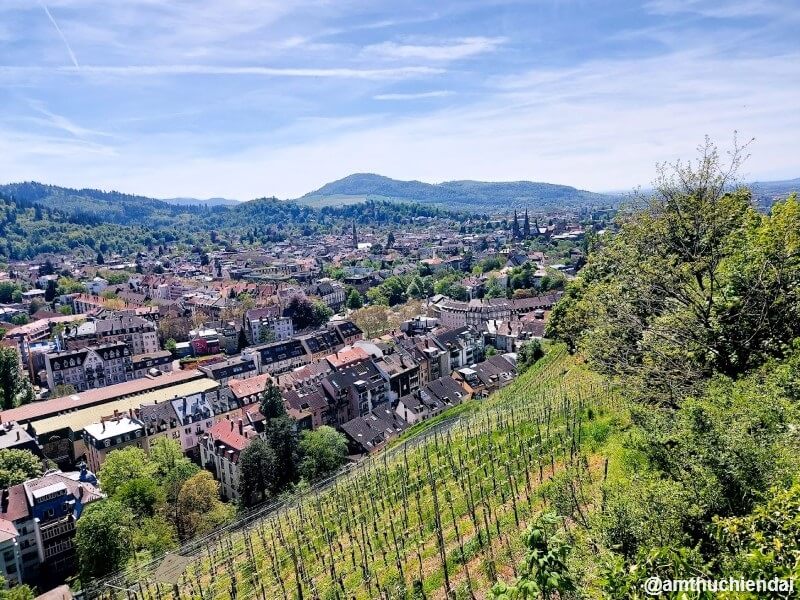
Because Yes, German wine is a real thing and should not be dismissed. This is what any wine enthusiast will say to you.
But of course, as a Frenchman from Alsace, this is not what I have been taught… I have been living a 30-minute drive from Freiburg but hardly tasted any wine from the Baden region.
This is of course because Alsace is one of the most renowned French wine regions especially when talking about white wine but not only…
So in this section, we’ll try to give you a few starting points on the wine you are likely to be able to find in Freiburg.
Like this, you won’t make the same mistake as me…
Main Characteristics
The most renowned German wines are Riesling, which is mostly produced in the Mosel, Rheingau, and Pfalz regions. However, Riesling is not the main grape variety in Baden.
What Baden region is offering is different:
- The region has a warm and dry climate (for German standards) that will allow the Baden region to produce wines that cannot be produced in the other parts of Germany.
- Baden is also the most spread out of Germany’s wine region. It forms a giant “L” shape, leaning slightly to the east as it follows the Rhine from the Bodensee (Lake Constance) to Mannheim.
- With a region spread out to such an extent – the soil variety is also important
This heterogeneity of terroirs, combined with climatic and cultural variations, account for the wide diversity of Baden’s wine portfolio making them particularly interesting.
Cepages
Unlike other parts of Germany, Baden region is mostly renowned for its Pinot:
- Pinot Noir (Spätburgunder): It accounts for almost 40% of the wine production in Baden, making red wines (Pinot Noir in particular) the specialty of the region.
- Pinot gris et Pinot Blanc (Grauer & Weißer Burgunder): The climate and soil of the region are favorable to these cousin varieties, and Baden can make some very decent wines from them.
- Müller-Thurgau: Like some other regions of Germany, you’ll find Müller-Thurgau in Baden. This grape variety was used to rebuild the German wine industry after World War II. At one point, more Müller-Thurgau came out of Germany than any other wine, but in the 1980s and 1990s commercial tastes changed and the variety became massively unpopular. Consequently, a significant portion of Germany’s Müller-Thurgau is progressively being pulled up and replaced with higher-quality grapes.
- Riesling: Even though it’s not the specialty of the region, you’ll find some Riesling in Baden. It accounts for between 5% and 10% of the vineyards in the region.
Baden Wine Route
If you really want to get into the wine from the Baden region, you’ll have to go out from Freiburg.
A great way to do it is to follow the Baden Wine Route, which has been established for over six decades. This runs from Heidelberg to Weil am Rhein on the Swiss border, with several loops and extensions. It takes in not only vineyard areas and seasonal tasting rooms but also numerous inns and Michelin-starred restaurants.
Biergartens (Beer Gardens)
Biergartens are a typical German experience. While not originating in Freiburg specifically, they are deeply embedded in the local culture. It’s impossible to truly experience Germany without trying one and Freiburg has several great options!
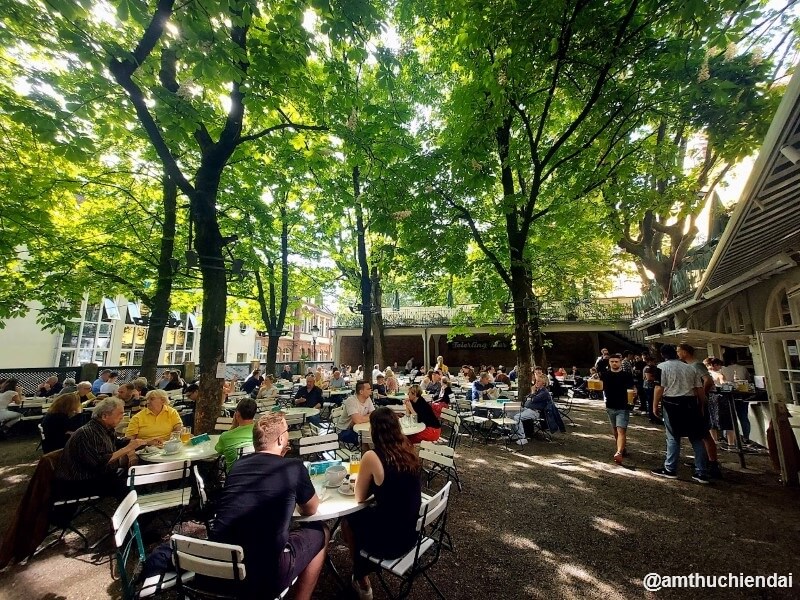
Origin and history of Germany’s Biergartens
Biergartens originated in Bavaria during the 19th century.
Brewers layered gravel upon their cellars and planted horse-chestnut trees overhead.This canopy kept the cellars cool while tables set up underneath served beer and food. Since then, Biergartens have become a summer staple across Germany.
If you’re interested in learning more about German beers, we have a full guide on the topic:
The Complete Guide to Traditional Bavarian Beers – Germany’s Best Brews
Biergartens in Freiburg
Like most German cities, Freiburg has several excellent Biergarten.
Hausbrauerei Feierling
Feierling claims to be the oldest Biergarten in the old town. It brews its own beer on-site. Up to 700 guests can be seated at its outdoor tables nested under authentic horse-chestnut trees. The drink menu features house-brewed beers and local wines.
We stopped by at the end of our day – it was perfect, a true quintessential German Biergarten experience.
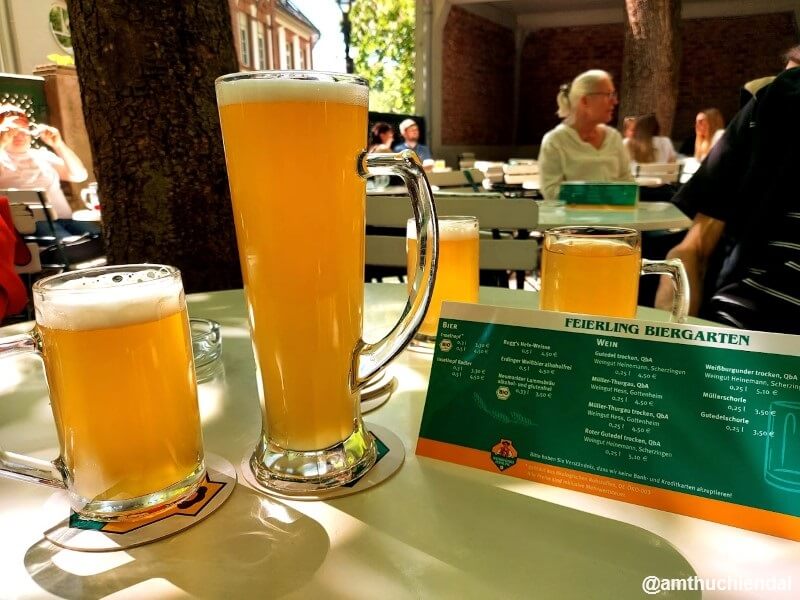
Kastaniengarten
Seeking a beer with a view? Kastaniengarten offers tables overlooking the city, installed on the foothills of the Schlossberg. This unbeatable vantage point unfortunately comes with elevated prices compared to other spots. For that reason, we favored the more affordable and authentic Feierling Biergarten without regret.
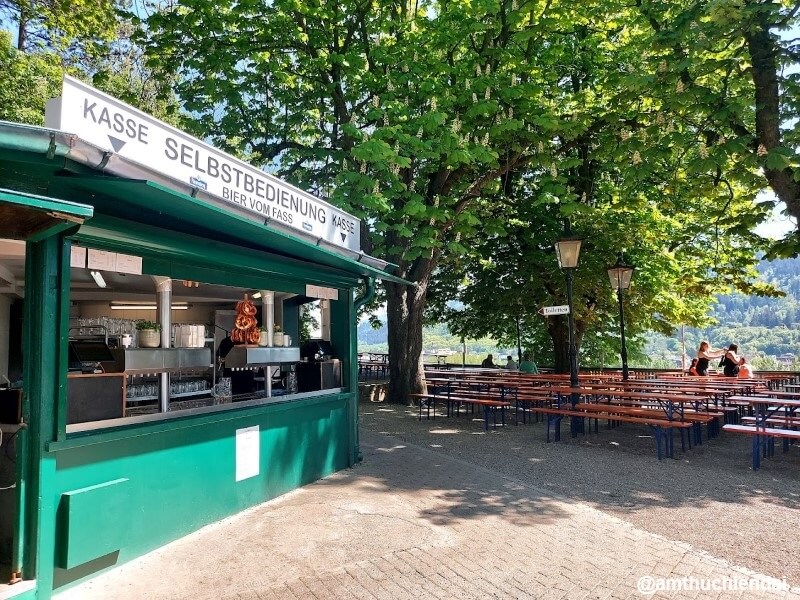
Kastaniengarten
Coffee Shops and Bakeries
Another quintessential part of German gastronomic culture widely represented in Freiburg is the abundance of enticing coffee shops and bakeries.
Kaffee und Kuchen
German baking is often associated with Black Forest cake, named after the famous mountain range bordering Freiburg. But we thought that it would be more interesting to highlight another tradition – “Kaffee und Kuchen.”
Kaffee und Kuchen is a beloved afternoon ritual where friends, family, and coworkers gather over coffee and cake between 3 and 4 pm to socialize and unwind. This national pastime takes place both at home and in coffee shops.
Coffee Shops and Bakeries in Freiburg
Freiburg’s old town hosts numerous coffee shops and bakeries to enjoy.
We stopped by Nóstimo Coffee during our visit for a quick coffee on the go or at their streetside seats. They offer an extensive range of coffee drinks from espresso to iced macchiatos.
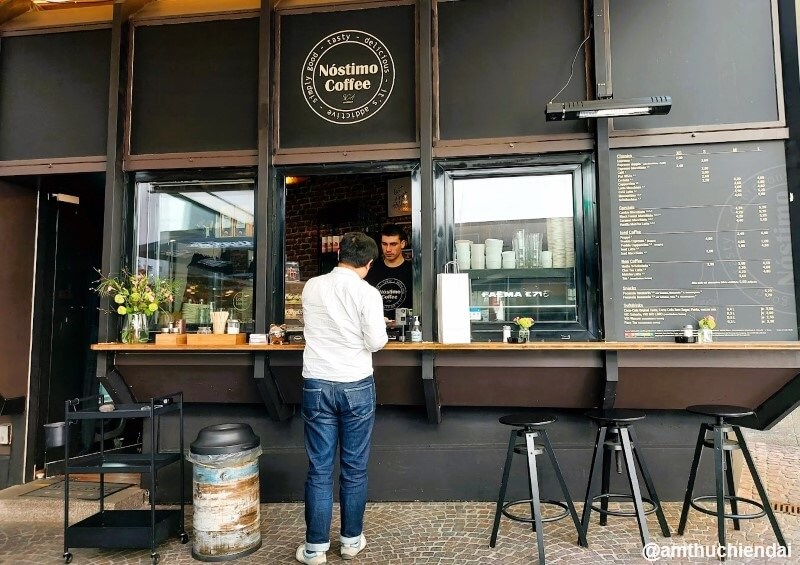
For more time to sit and savor, locals highly recommend Au Contraire behind the small Gwerbekanal. Renowned for cakes, tartines, and drinks, they also offer multiple options suitable for Vegans.
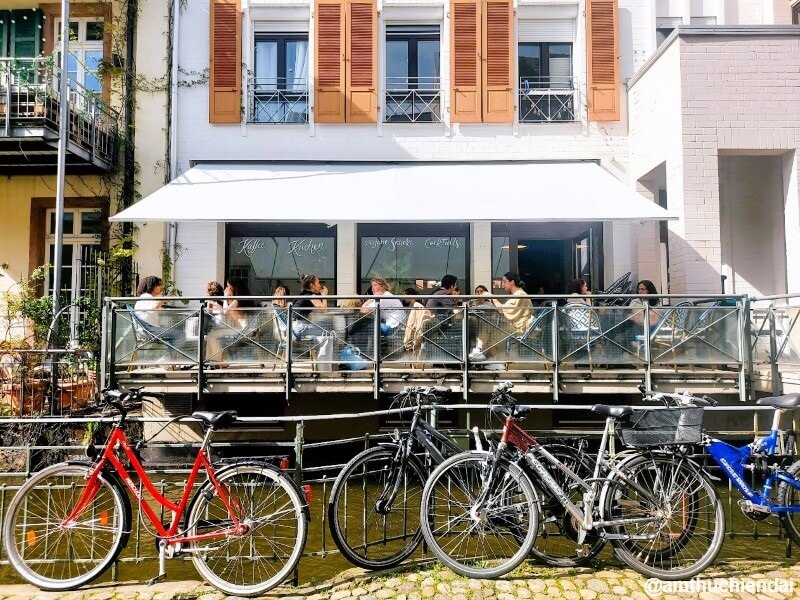
Seeking a traditional bakery? Bäckerei Pfeifle is a Freiburg institution with several locations. It’s a perfect stop for freshly baked goods.
An Environmental and Pedestrian Friendly City
Freiburg’s vibrant outdoor scene during spring and summer is not just tradition – it’s also due to the city’s forward-thinking approach to sustainability. In 2010, Freiburg was voted the Academy of Urbanism’s European City of the Year, recognizing the exemplary sustainable urbanism implemented over past decades.
Like many German cities, Freiburg banned cars and motorcycles from its city center years ago before this became a broader European trend. This created more space for outdoor terraces where people could relax and enjoy food and drink without noise and fumes.
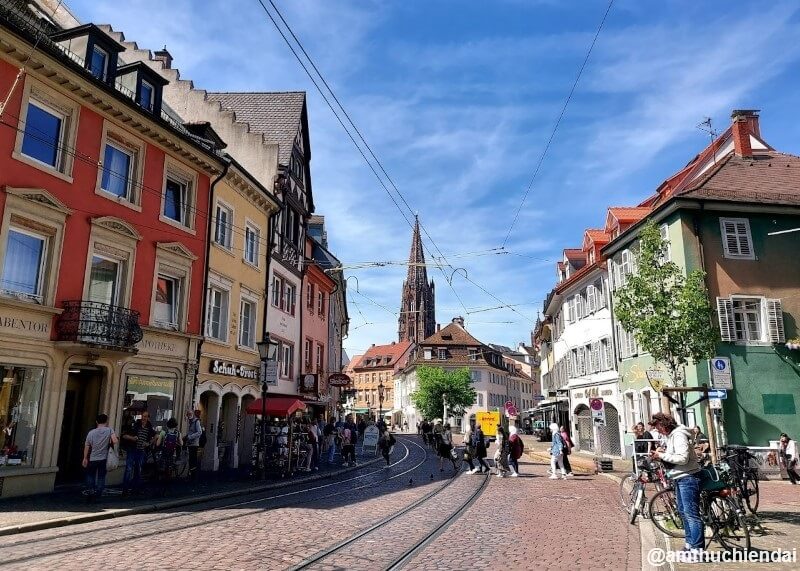
This mindset extended beyond the center too. In 1998, when the city built the new Vauban district on a former French military base, they designed it as a model sustainable neighborhood. This district is now a city landmark that draws architects and urbanism enthusiasts. Unfortunately, we did not have time to visit this innovative area.
Near Freiburg
As mentioned at the start of this article, Freiburg is great but you also have much to discover in its immediate surroundings.
Black Forest: Freiburg is literally located at the foot of this renowned large forested mountain range. There are multiple ways to discover it, but an easy starting point is taking the Schauinslandbahn, a cable car (Germany’s longest) that will connect Horben (a village south of Freiburg) to Schauinsland, a 1,200-meter-high mountain.
Alsace: Well – I may be very partial here as it’s where I’m from. But ask around if Alsace is worth visiting and everybody should answer you the same. Main interests range from its three major cities (Strasbourg – Mulhouse – Colmar) to its numerous beautiful villages located at the foot of the Vosges mountain range to the Vosges themselves. This is an area we will cover extensively in all its aspects in future articles, so stay tuned.
Basel: Less renowned than other parts of Switzerland, Basel remains a truly charming city with plenty of offerings, especially if you have an interest in art.
Europa Park Rust: The power of the Disney brand sometimes makes “smaller players” in the amusement park field have a hard time making themselves known internationally. If you have any interest in this type of entertainment, do not overlook Europa Park, founded by the Mack families who have been designing and building rides for parks worldwide. This expertise explains the quality and quantity of roller coasters available, making it one of Europe’s most renowned parks.

